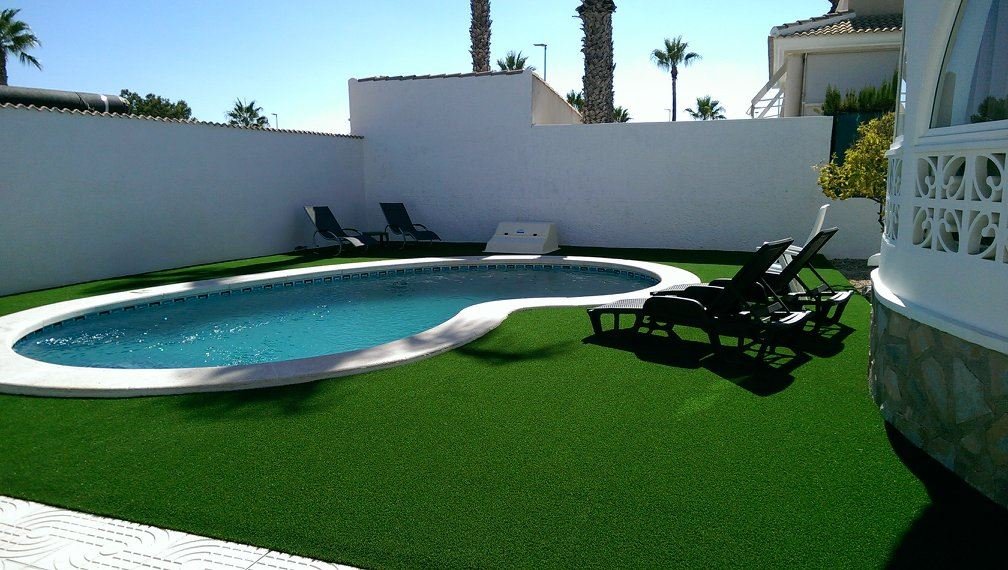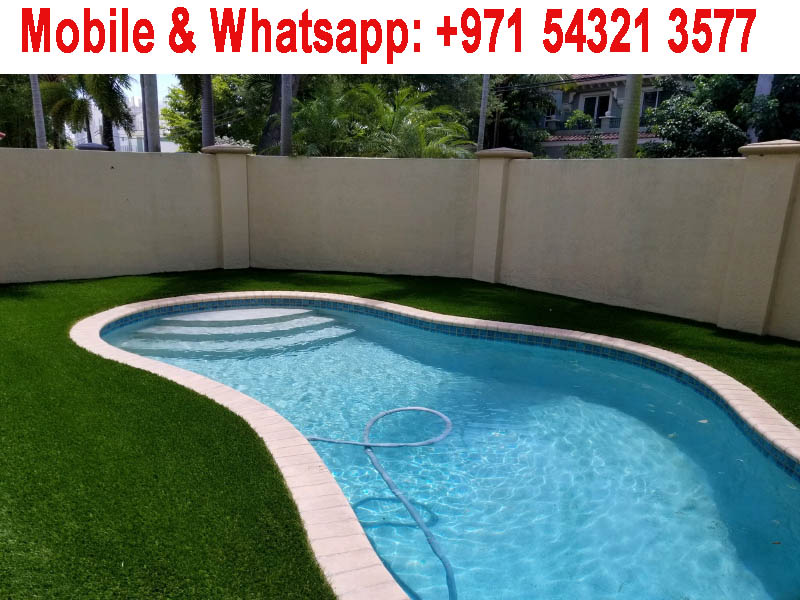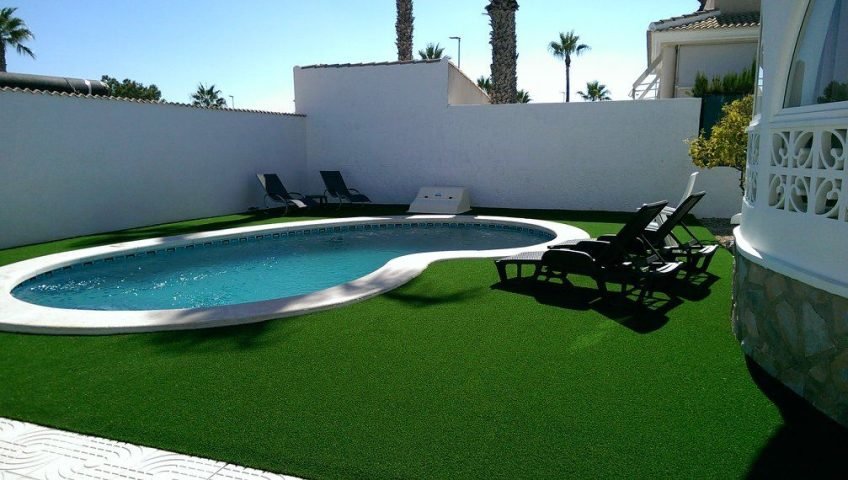A pool area can be a relaxing oasis in your backyard, Artificial Grass for Pool Areas, but it can also be a potential hazard if the ground around the pool is slippery or prone to pooling water. This is where artificial grass comes in as a slip-resistant and water-draining solution that can make your pool area safer and more visually appealing.
Artificial grass is a synthetic turf made from a combination of materials such as nylon, polyethylene, or polypropylene. It is designed to look and feel like real grass, but with the added benefits of being slip-resistant and water-draining. This makes it an ideal material for pool areas, where safety and functionality are key considerations.

One of the main advantages of artificial grass for pool areas is its slip-resistant properties. The surface of artificial grass is designed to provide better traction than traditional pool decking, which can be slick when wet. This can help prevent slips and falls, especially for children or elderly people who are more prone to accidents.
Another advantage of artificial grass for pool areas is its water-draining capabilities. Natural grass can become soggy and muddy around a pool area, creating a slipping hazard and a breeding ground for insects. In contrast, artificial grass is designed with drainage holes that allow water to quickly and efficiently drain away from the surface. This not only helps prevent slipping but also reduces the risk of standing water, which can attract mosquitoes and other pests.
Artificial Grass for Pool Areas
Artificial grass is also a low-maintenance option for pool areas. Unlike natural grass, which requires regular mowing, watering, and fertilizing, artificial grass is virtually maintenance-free. It doesn’t need to be watered, mowed, or fertilized, making it a cost-effective and time-saving solution for pool owners.
Another benefit of artificial grass for pool areas is its durability. Unlike natural grass, which can become damaged or discolored over time, artificial grass is designed to withstand heavy foot traffic, harsh weather conditions, and exposure to pool chemicals.
This means that it will maintain its color and texture for years, making it a long-term investment for your pool area.
In terms of installation, artificial grass for pool areas is typically installed over a compacted base layer of gravel and sand. This helps to promote proper drainage and prevent the grass from shifting or settling over time. It is also important to choose an artificial grass product that is specifically designed for pool areas, as these products are typically more slip-resistant and water-draining than standard artificial grass.
Artificial grass for swimming Pool
When it comes to design, artificial grass for pool areas can be customized to fit your specific style and preferences. It comes in a range of colors and textures, so you can choose a grass that complements the rest of your outdoor decor.
You can also incorporate other design elements such as pavers, stones, or decorative rocks to create a unique and visually appealing pool area.
In terms of cost, artificial grass for pool areas can be more expensive than traditional pool decking options such as concrete or wood. However, it is important to consider the long-term cost savings in terms of maintenance and replacement. Artificial grass is a durable and long-lasting option that can save you time and money in the long run.

Pros and Cons of Artificial Grass Around Pool
Artificial grass is becoming an increasingly popular choice for homeowners looking to spruce up their outdoor spaces, particularly around pool areas. However, like any landscaping decision, there are pros and cons to consider before making the investment. In this blog post, we’ll explore the benefits and drawbacks of installing artificial grass around your pool.
Pros of Artificial Grass Around Pool: artificial turf around pool cost
Low Maintenance: One of the biggest benefits of installing artificial grass around your pool is the low maintenance requirements. Unlike natural grass, synthetic turf doesn’t require regular watering, mowing, or fertilizing, saving you both time and money.
No Pesticides: Pesticides can be harmful to both people and pets, so avoiding their use is always a plus. With artificial grass, there’s no need to apply any chemicals, making it a safer option for your family and the environment.
Slip-Resistant: Another advantage of artificial grass is that it can be designed to be slip-resistant, making it a safer surface around the pool. The synthetic fibers can be treated with a non-slip coating, reducing the risk of slips and falls.
Durability: Synthetic turf is known for its durability and can withstand heavy foot traffic, as well as exposure to chlorine and other pool chemicals. It won’t fade or discolor over time, meaning you won’t have to worry about replacing it anytime soon.
Aesthetically Pleasing: Artificial grass can provide a clean, uniform look to your pool area, giving it a modern and sophisticated feel. With a range of colors and textures to choose from, you can customize the look to suit your taste and style.
Cons of Artificial Grass Around Pool:
Heat Retention: Synthetic turf can retain heat, making it uncomfortable to walk on during hot summer days. This can be especially problematic around pool areas, where people are often barefoot.
Drainage: Proper drainage is essential around pool areas to avoid water buildup, which can create a breeding ground for insects and bacteria. Synthetic turf can be designed to allow for adequate drainage, but if not installed correctly, it can pose a problem.
Initial Cost: The upfront cost of installing artificial grass around your pool can be more expensive than natural grass. However, over time, the savings on maintenance and water bills can make it a cost-effective option.
Appearance: While many people find artificial grass to be aesthetically pleasing, some may prefer the look and feel of natural grass. The synthetic fibers can feel different underfoot, and it may not provide the same level of authenticity as natural grass.
Environmental Impact: Although artificial grass doesn’t require water or chemicals, it is made from non-biodegradable materials and can contribute to environmental waste when it eventually needs to be replaced.
Artificial grass around pool areas can be a great option for homeowners looking for a low-maintenance, slip-resistant, and durable solution. However, it’s important to consider the potential drawbacks, such as heat retention and drainage issues. Ultimately, the decision should be based on your personal preferences, budget, and environmental concerns.
Installing Artificial Turf Around Pool : Best artificial grass for pool area
Installing artificial turf around a pool is a great way to create a low-maintenance and aesthetically pleasing outdoor space. However, it’s important to know the proper steps to take to ensure a successful installation. In this blog post, we’ll walk you through the process of installing artificial turf around your pool.
Step 1: Preparation
Before you start installing artificial turf around your pool, you need to properly prepare the area. This involves removing any existing grass, weeds, and debris from the surface. If the area is uneven, you may need to level it using a rake or shovel.
Step 2: Install a Sub-Base
The next step is to install a sub-base, which is a layer of crushed stone or gravel that provides a stable base for the artificial turf. The sub-base should be compacted to create a smooth and level surface.
Step 3: Lay the Artificial Turf
Once the sub-base is in place, it’s time to lay the artificial turf. The turf should be rolled out over the sub-base, with the edges overlapping the pool deck or surrounding area. If necessary, you can trim the edges of the turf using a utility knife.
Step 4: Secure the Edges
To keep the artificial turf in place, you’ll need to secure the edges. This can be done using landscape staples or by applying a special adhesive designed for artificial turf. Be sure to follow the manufacturer’s instructions when applying the adhesive.
Step 5: Add Infill
Infill is a material that is added to the artificial turf to help it stand up and provide cushioning underfoot. The type of infill you use will depend on your personal preference and the type of artificial turf you have. Some common options include sand, rubber, and cork.
Step 6: Clean and Maintain
Once the artificial turf is installed, it’s important to keep it clean and well-maintained. This involves removing any debris, such as leaves and dirt, on a regular basis. You may also need to rinse the turf with water occasionally to keep it looking fresh and clean.
In conclusion, artificial grass is a slip-resistant and water-draining solution that can make your pool area safer and more visually appealing. With its low-maintenance and durable properties, it is a long-term investment that can provide years of enjoyment for you and your family. Whether you are looking to renovate an existing pool area or create a new one from scratch, artificial grass is a versatile and functional option that is worth considering.
Grass Carpet Dubai is Best Artificial Grass Suppliers and Installation Service Provider company in Dubai. Suppliers for Home, Commercial Businesses, Education Center, Sports & Play Areas, ETC.
High-Quality Artificial Turf For Landscaping, Playgrounds & Kids’ Play Area. Benefits: No More Watering, Significant Short & Long Term Cost Savings, No More Cutting.
More Details Please Contact Us.
Mobile & Whatsapp: +971 54321 3577
Website: www.grasscarpetdubai.com
Email: grasscarpetdubai@gmail.com
Address: Dragon Mart-01, AL Awir Road, Dubai, UAE.

